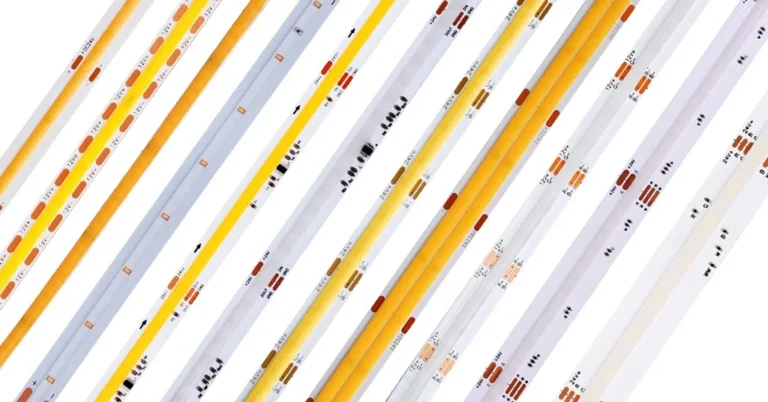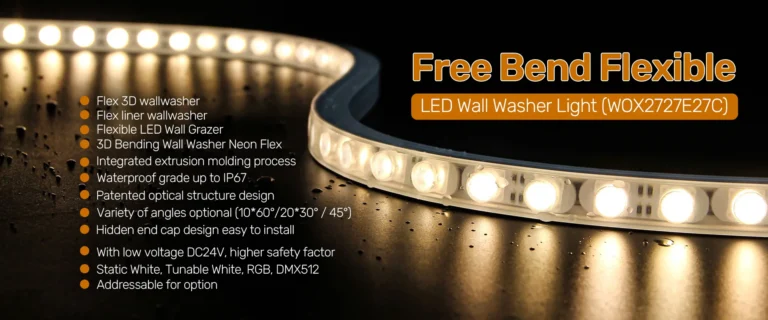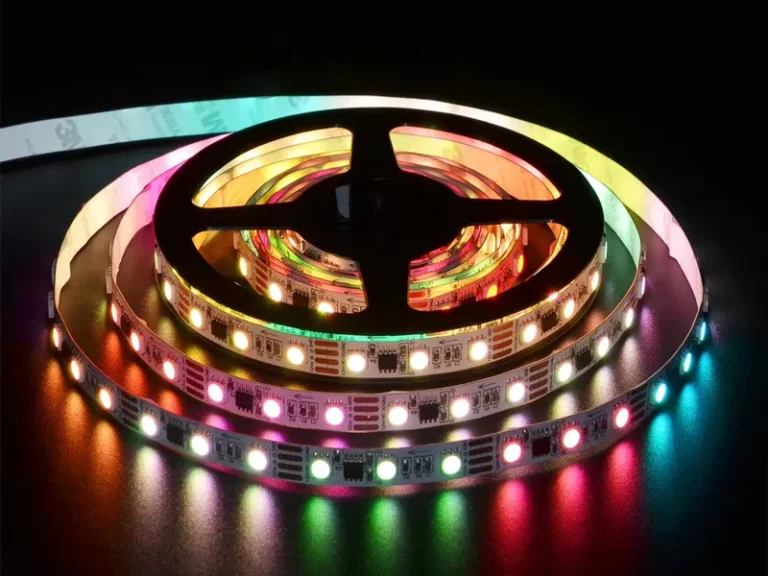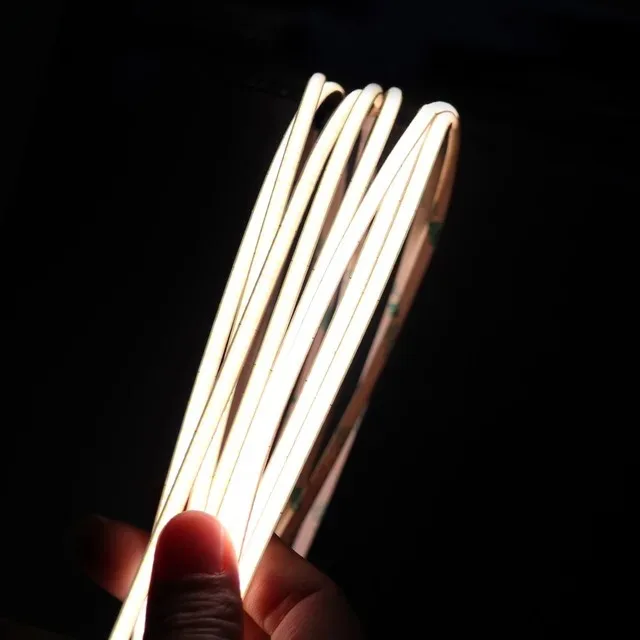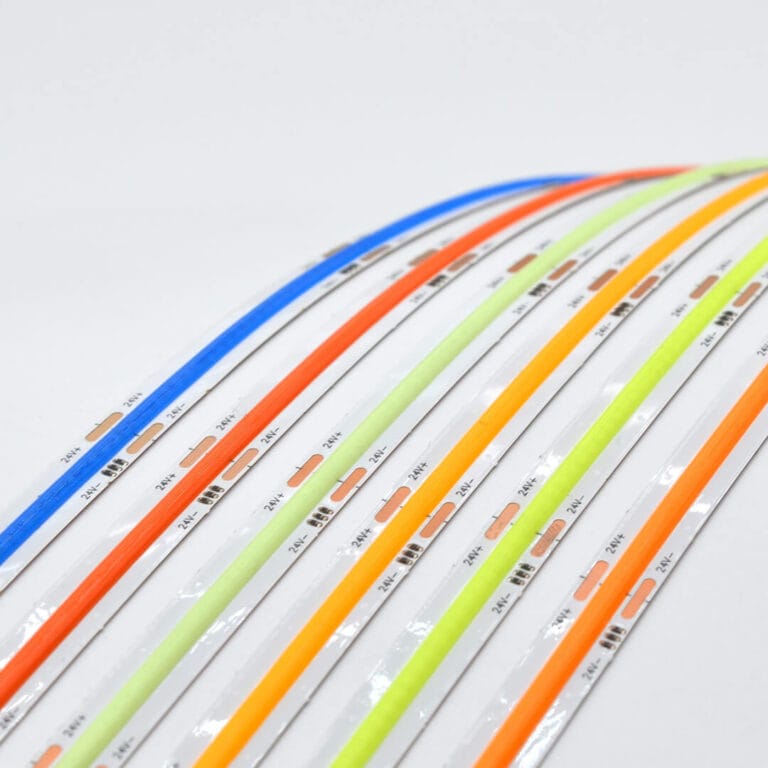عند التخطيط لحلول الإضاءة لمشروعك المعماري أو التجاري أو الإبداعي، فإن اختيار نيون فليكس (ليد) المناسب أمر بالغ الأهمية. يؤثر نوع شرائط (ليد نيون فليكس) التي تختارها على المظهر الجمالي والأداء والميزانية والكفاءة التشغيلية على المدى الطويل لمشروعك. تُعد شرائط (RGB) و (RGBW) من شرائط نيون فليكس (ليد) خياران شائعان، حيث يقدم كل منهما حلول إضاءة قابلة للتخصيص لتناسب احتياجات التصميم المختلفة. ومع ذلك، يختلف هذان الخياران اختلافًا كبيرًا في جوانب رئيسية مثل جودة الألوان وكفاءة الطاقة وأنظمة التحكم. سيقدم هذا الدليل مقارنة متعمقة بين شرائط إضاءة (RGB) و (RGBW) نيون فليكس (RGBW)، مع تسليط الضوء على مزايا وعيوب كل منهما والتطبيقات المثلى لكل منهما. يمكنك من خلال التسلح بهذه المعرفة اتخاذ قرار مستنير يتماشى مع أهداف مشروعك، مما يضمن لك الأداء والفعالية من حيث التكلفة.
ما هي مصابيح RGB و RGBW LED المرنة RGBW، ولماذا هي شائعة؟
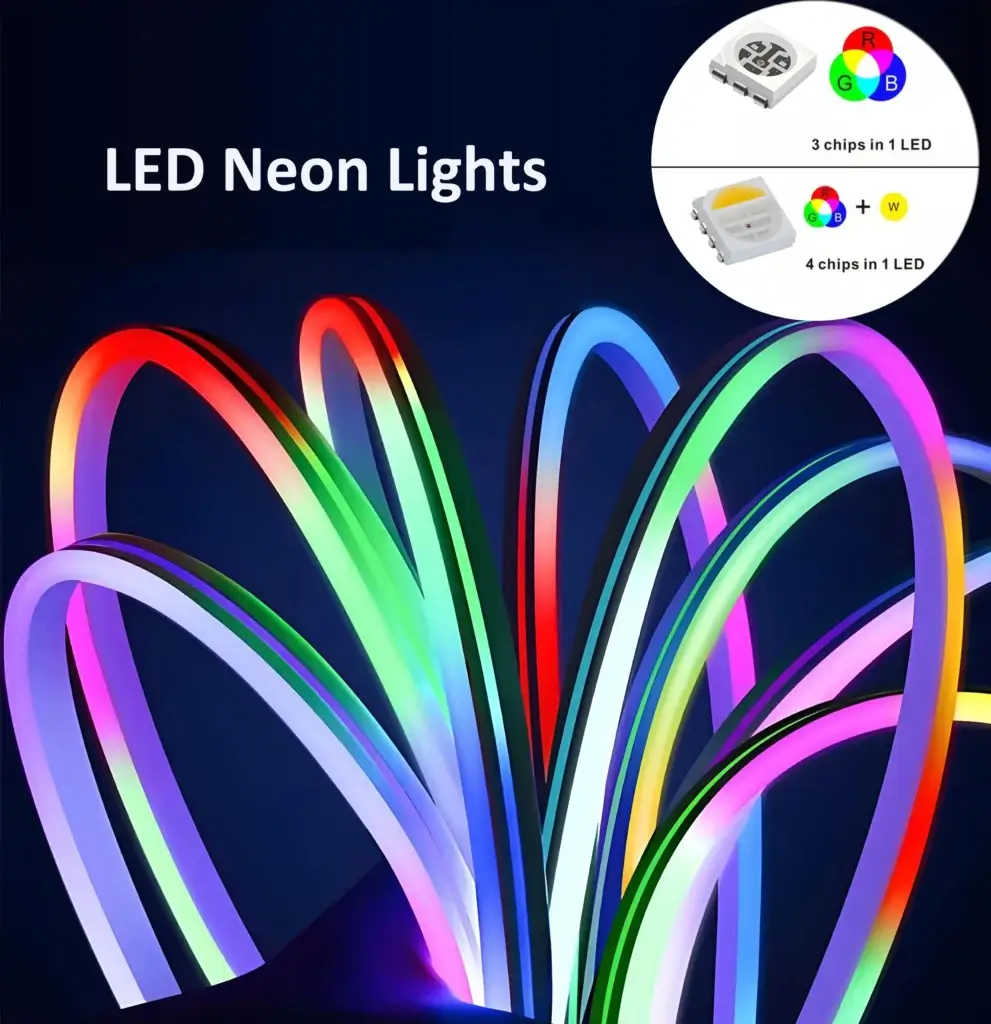
نيون فليكس LED هو بديل عصري للنيون الزجاجي التقليدي - مرن وموفر للطاقة ومتين للغاية. وهي مصنوعة من مواد مثل السيليكون أو PVC، وتعمل بجهد منخفض (12 فولت أو 24 فولت تيار مستمر)، مما يجعلها خياراً آمناً للتطبيقات الداخلية والخارجية على حد سواء. تسمح قدرتها على الانحناء حول المنحنيات والحواف للمصممين بإنشاء خطوط إضاءة سلسة للواجهات المعمارية أو اللافتات التجارية أو بيئات العرض الغامرة. سواءً كان ذلك لتخطيط المباني أو لإبراز ميزات التصميم، توفر مصابيح LED نيون فليكس سطوعاً ثابتاً بأقل قدر من الحرارة، مما يجعلها مثالية لبيئات الأعمال ذات الازدحام الشديد. صُممت شاشات LED Neon Flex من أجل الأداء، وغالبًا ما تكون مصنفة IP67 أو IP68، وهي مقاومة للماء والأشعة فوق البنفسجية والغبار، مما يجعلها حلاً موثوقًا للاستخدام الخارجي. تضمن صيانته المنخفضة وعمره التشغيلي الطويل حصول عملاء الأعمال على عائد استثماري قوي لمشاريعهم.
مصابيح RGB LED نيون فليكس ضوئية
RGB LED نيون فليكس هو حل إضاءة مرن يستخدم ثلاث شرائح ألوان أساسية - الأحمر والأخضر والأزرق - لإنشاء مجموعة كبيرة من الألوان. من خلال ضبط شدة كل قناة، يمكن للمستخدمين توليد تأثيرات إضاءة نابضة بالحياة وكاملة الألوان. ومع ذلك، عادةً ما تنتج شرائط RGB LED عادةً لونًا أبيض مزرقًا عند دمجها بكثافة كاملة. وهذا ما يجعلها مثالية للتطبيقات التي تتطلب إضاءة ديناميكية ملونة بدلاً من الضوء الأبيض الدقيق
الميزات الرئيسية
1. تخصيص واسع النطاق للألوان: يوفر RGB نيون فليكس مجموعة رائعة من الألوان
تركيبات وأوضاع ديناميكية، بما في ذلك تلاشي الألوان والنبض والتأثيرات المتلألئة والمطاردة. يمكن برمجة هذه المؤثرات المرئية بسهولة من خلال وحدات تحكم متوافقة، مما يجعل النظام مثاليًا لتصميمات الإضاءة الغامرة.
2. نظام تحكم مبسط: يعمل نظام RGB على 3 قنوات
التكوين (R، G، B)، مما يجعل بنية التحكم أبسط وأكثر ملاءمة للميزانية مقارنةً بالأنظمة القائمة على RGBW أو الأنظمة القائمة على البكسل. يقلل هذا من تعقيد الأسلاك والتحكم، وهو أمر مفيد في التركيبات الحساسة من حيث التكلفة أو التركيبات المدمجة.
3. خيار فعال من حيث التكلفة: نظرًا لتصميمها الأبسط وقنوات التحكم الأقل عددًا، فإن RGB
عادةً ما يكون نيون فليكس أقل تكلفة من بدائل RGBW. وهذا ما يجعلها مناسبة بشكل خاص للتركيبات المبتدئة أو المشاريع ذات ميزانيات الإضاءة المحدودة التي لا تزال تتطلب نتائج لافتة للنظر.
أفضل التطبيقات:
1. الإضاءة الترفيهية: تُستخدم RGB Neon Flex على نطاق واسع في النوادي وأماكن الموسيقى والمتنزهات الترفيهية وخلفيات المسارح، حيث تساهم الألوان الغنية والمتغيرة باستمرار في إضفاء أجواء مفعمة بالحيوية والنشاط.
2. الفعاليات والتركيبات المؤقتة: مثالية للمعارض التجارية والمعارض والمسرح
في المناسبات وديكورات العطلات، يسمح هذا النوع من شرائط LED بالإعداد السريع والتأثيرات البصرية المؤثرة التي تجذب الانتباه دون استثمار كبير.
3. ديكور المنزل: في البيئات السكنية، تضيف RGB LED نيون فليكس
شخصية لغرف نوم الأطفال وغرف الألعاب والمسارح المنزلية، مما يوفر إضاءة محيطة قابلة للتخصيص تعزز الحالة المزاجية والتجربة.
4. إضاءة عرض التجزئة: غالبًا ما تستخدم المتاجر الصغيرة والمتاجر المنبثقة RGB Neon Flex في
عروض النوافذ، واللافتات واللافتات، والجدران المميزة التي تجذب العملاء بالحركة والألوان دون تجاوز قيود الميزانية.
هل لديك فضول لمعرفة كيف تبدو في الحياة الواقعية؟ شاهد هذا الفيديو التوضيحي

مصابيح LED نيون مرنة RGBW LED
يعمل RGBW LED Neon Flex على تحسين إضاءة RGB التقليدية من خلال إضافة شريحة LED بيضاء. يتيح ذلك للشريط إنتاج إضاءة بيضاء نقية وحقيقية - وهو مثالي للتطبيقات التي تتطلب ألوانًا زاهية وإضاءة بيضاء واضحة. تُستخدم إضاءة RGBW نيون فليكس على نطاق واسع في البيئات الاحترافية والراقية حيث تكون دقة الألوان ودقة الإضاءة ضرورية.
الميزات الرئيسية
1. إخراج ضوء أبيض حقيقي: مع شريحته البيضاء المخصصة، RGBW LED نيون فليكس
يوفر إضاءة بيضاء نظيفة ومتسقة بدرجات حرارة لونية مختلفة - من الأبيض الدافئ (2700 كلفن - 3000 كلفن) للبيئات المريحة إلى الأبيض البارد (5000 كلفن - 6500 كلفن) للإعدادات العصرية الواضحة. هذه المرونة تجعلها خيارًا ممتازًا للمساحات التي تتطلب تأثيرات لونية محيطة وإضاءة بيضاء عملية.
2. عرض ألوان محسّن: تُحسِّن إضافة القناة البيضاء بشكل كبير
مؤشر تجسيد اللون (CRI)، مما يضمن ظهور الأجسام المضيئة بشكل أكثر طبيعية وأقرب إلى ألوانها الحقيقية. هذا الأمر مهم بشكل خاص في الأماكن التي يكون فيها العرض المرئي أمرًا بالغ الأهمية، مثل المعارض الفنية وتجارة التجزئة الفاخرة وقاعات العرض.
3. أكثر إشراقاً وكفاءة في استهلاك الطاقة: عادةً ما توفر شرائط RGBW LED أعلى
مستويات السطوع مقارنةً بمصابيح RGB، خاصةً عند استخدام الضوء الأبيض بمفرده. نظرًا لأن النظام لا يعتمد على قنوات RGB الزائدة لإنشاء اللون الأبيض، فإنه يقلل من استهلاك الطاقة وإنتاج الحرارة مع إطالة عمر مصابيح LED.
4. إمكانيات تحكم أكبر: التشغيل على نظام 4 قنوات (R، G، B، W)
تتيح لك إضاءة RGBW انتقالات أكثر سلاسة ودرجات ألوان الباستيل الأكثر نعومة ومزجًا أكثر دقة بين الضوء الملون والأبيض. وهذا يتيح لك تصميم إضاءة أكثر تطوراً، وهو ما يجعل الإضاءة أكثر تعقيداً ووظيفية وجوانية.
أفضل التطبيقات:
1. الإضاءة المعمارية: مثالية لواجهات المباني، والخطوط العريضة للجسور، والإضاءة العامة
النصب التذكارية، حيث يكون تنوع الألوان والإضاءة البيضاء النقية ضروريين.
2. البيئات التجارية المتميزة: يشيع استخدامها في صالات العرض الراقية,
متاجر المصممين والمتاجر الرئيسية للعلامات التجارية لتعزيز رؤية المنتج والأجواء المحيطة به من خلال إضاءة عالية الجودة.
3. مساحات للفنون والمعارض: مثالية للمتاحف وصالات العرض والمؤسسات الثقافية,
حيث يجب ألا تشوه الإضاءة مظهر الأعمال الفنية والتحف الفنية.
4. المشاريع السكنية الذكية: تحظى بشعبية متزايدة في المنازل الفاخرة والذكية
الديكورات الداخلية، حيث يبحث المستخدمون عن إضاءة متعددة الاستخدامات تنتقل من إضاءة مزاجية مفعمة بالحيوية RGB إلى إضاءة بيضاء مريحة وعملية للاستخدام اليومي.
| جدول المقارنة السريعة: RGB مقابل RGBW | ||
| الميزة | RGB نيون فليكس | RGBW نيون فليكس |
| تكوين الصمام الثنائي الباعث للضوء | أحمر، أخضر، أزرق | أحمر، أخضر، أخضر، أزرق، أبيض |
| ناتج الضوء الأبيض | مختلط (مزرق، غير طبيعي) | أبيض حقيقي (خيارات دافئ/محايد/بارد) |
| نطاق الألوان | ألوان واسعة ونابضة بالحياة | نطاق أوسع بما في ذلك ألوان الباستيل |
| قنوات التحكم | 3 (ص، ز، ب) | 4 (R، G، B، W) |
| استهلاك الطاقة | أعلى عند إنتاج اللون الأبيض | أقل عند استخدام شريحة W وحدها |
| تعقيد التركيب | معتدل | أعلى |
| أفضل حالات الاستخدام | مشاريع الميزانية والعروض الملونة | بيئات عالية الجودة ودقيقة الألوان |
| التكلفة | أقل | أعلى |
أنظمة التحكم RGB مقابل RGBW: ما تحتاج إلى معرفته
عند الاختيار بين RGB و RGBW LED نيون فليكس، يلعب اختيار نظام التحكم دورًا حاسمًا في الأداء العام ونتائج التطبيق. لا يحدد نظام التحكم ليس فقط تغيرات اللون والسطوع في شرائط (ليد) بل يؤثر أيضًا على تفاعل الإضاءة وتأثيرات الرسوم المتحركة والمزامنة. واعتمادًا على بنية التحكم المختارة، تختلف طرق التحكم في أنظمة RGB و RGBW، حيث يوجد نوعان رئيسيان من أنظمة التحكم: التحكم في المجموعة والتحكم في البكسل.
1. نظام التحكم في المجموعة
أنظمة التحكم في المجموعة هي الطريقة الأبسط والأكثر فعالية من حيث التكلفة، مما يجعلها مثالية للمشاريع التجارية ذات الميزانية المحدودة التي تتطلب ألوانًا ثابتة أو تأثيرات انتقالية أساسية. في نظام التحكم هذا، تقوم جميع مصابيح LED في قسم أو شريط بتغيير اللون في وقت واحد، مع عرض نفس اللون والسطوع عبر الشريط بأكمله. ويتميز هذا الأسلوب بسهولة التركيب والصيانة، وغالبًا ما يُستخدم في الإضاءة المعمارية واسعة النطاق أو ديكورات الأسقف أو تركيبات اللافتات الخارجية حيث يكون التوحيد والبساطة أمرًا أساسيًا.
المزايا:
تكلفة أقل، مما يجعلها مناسبة للمشاريع ذات الميزانية المحدودة.
تأثيرات تزامن بسيطة، مثالية للمناطق الكبيرة التي تتطلب إضاءة موحدة.
سهولة التركيب والصيانة مع الحد الأدنى من متطلبات نظام التحكم.
العيوب:
لا يمكن دعم الرسوم المتحركة المعقدة أو تأثيرات الإضاءة الديناميكية.
تقتصر على الألوان الثابتة والانتقالات الأساسية.
يفتقر إلى القدرة على التحكم في مصابيح LED الفردية، مما يحد من العروض الديناميكية المضبوطة بدقة.
2. نظام التحكم في البكسل
أنظمة التحكم بالبكسل أكثر تقدمًا وتوفر تحكمًا فرديًا في كل مصباح LED (أو مجموعات صغيرة من مصابيح LED)، مما يتيح تأثيرات ضوئية معقدة ودقيقة. يمكن ضبط كل مصباح LED بشكل مستقل من حيث اللون والسطوع والرسوم المتحركة، مما يسمح لشرائط RGB أو RGBW بعرض تأثيرات ديناميكية، مثل أنماط الضوء المتدفقة، والمطاردة، والوميض، وغيرها من الرسوم المتحركة النابضة بالحياة. تستخدم طريقة التحكم هذه عادةً بروتوكولات SPI (الواجهة الطرفية التسلسلية) أو بروتوكولات DMX512 لنقل البيانات، مما يجعلها مثالية للإضاءة التجارية المتطورة واللافتات الرقمية والتركيبات التفاعلية وتصميم المسرح الاحترافي.
نظام التحكم SPI: SPI هو بروتوكول نقل بيانات سريع ومثالي لتركيبات مصابيح (ليد) ذات المسافات القصيرة والكثافة العالية. ويُستخدم بشكل شائع في اللافتات الرقمية والإضاءة الداخلية الإبداعية وشاشات العرض المرئية صغيرة الحجم. توفر أنظمة SPI أوقات استجابة سريعة وتدعم التأثيرات في الوقت الفعلي مثل التدفق والبهتان والوميض.
نظام التحكم DMX: يُعد نظام DMX هو معيار الصناعة للتحكم الاحترافي في الإضاءة عن بُعد، وغالبًا ما يُستخدم في تصميم المسارح والواجهات المعمارية والتركيبات الفنية العامة التفاعلية. تسمح أنظمة DMX لوحدة تحكم واحدة بإدارة المئات أو حتى الآلاف من قنوات (ليد)، مما يضمن مزامنة وثباتًا موثوقًا به، مما يجعلها مثالية للتركيبات واسعة النطاق التي تتطلب تحكمًا دقيقًا وتخصيصًا دقيقًا.
المزايا:
يدعم الرسوم المتحركة الضوئية المعقدة والتأثيرات التفاعلية والتأثير البصري العالي.
يسمح بالتحكم الدقيق في كل مصباح LED، مما يوفر مرونة إبداعية أكبر.
مثالية للفن الرقمي، والعروض المسرحية، ومشاريع الإضاءة الإبداعية المتطورة.
يتوافق SPI و DMX مع وحدات تحكم الإضاءة الاحترافية وخوادم الوسائط.
العيوب:
تكلفة أعلى، تتطلب تركيباً وتهيئة أكثر تعقيداً.
يتطلب طاقة وسعة نقل بيانات أكبر، مما يتطلب تخطيطًا دقيقًا للأسلاك ومصادر الطاقة.
تُعد عمليات التركيب والصيانة أكثر صعوبة وغالباً ما تتطلب دعماً فنياً احترافياً.
3. الاختلافات بين أنظمة التحكم RGB و RGBW
عادةً ما يستخدم نظام RGB LED نيون فليكس نظام تحكم ثلاثي القنوات (أحمر وأخضر وأزرق)، مما يجعل نظام التحكم الخاص به بسيطًا نسبيًا ومثاليًا لحلول الإضاءة التجارية الفعالة من حيث التكلفة. وهو مثالي للتغييرات اللونية الديناميكية وتأثيرات الإضاءة النابضة بالحياة في المشروعات التي تكون فيها قيود الميزانية في الاعتبار. هذا النظام مناسب بشكل خاص للتطبيقات التي تحتل فيها التأثيرات الملونة مركز الصدارة، مثل المعارض التجارية وبيئات البيع بالتجزئة والتركيبات المؤقتة.
من ناحية أخرى، يتطلب نظام RGBW LED نيون فليكس نظام تحكم رباعي القنوات (الأحمر والأخضر والأزرق والأبيض)، مما يوفر تحكمًا أكبر في إخراج الضوء الأبيض الدقيق ويوفر انتقالات أكثر سلاسة بين الألوان. وهو مثالي لبيئات الإضاءة التجارية المتميزة، مثل مساحات البيع بالتجزئة الفاخرة والواجهات المعمارية والمتاحف، حيث تكون تأثيرات الألوان والضوء الأبيض عالي الجودة أمرًا ضروريًا.
ملخص
عند اختيار نظام تحكم لـ RGB و RGBW LED Neon Flex، يجب أن يعتمد القرار على متطلبات المشروع والميزانية وتعقيد التحكم والتأثير المرئي المطلوب. بالنسبة للمشاريع الأبسط والأكثر ملاءمة للميزانية، تكفي أنظمة التحكم الجماعية التي توفر مزامنة مباشرة للألوان. ومع ذلك، بالنسبة للمشاريع التي تتطلب تحكمًا دقيقًا ورسومًا متحركة معقدة ومؤثرات بصرية متطورة، توفر أنظمة التحكم بالبكسل (SPI/DMX) حرية أكبر وإمكانيات إبداعية. تسمح هذه الأنظمة بالتحكم الدقيق في مصابيح (ليد) الفردية، مما يتيح لك عرض إضاءة أكثر ثراءً وديناميكية.
يعد اختيار نظام التحكم المناسب أمرًا ضروريًا لتحقيق تجربة الإضاءة المرغوبة، سواءً كان ذلك من خلال عرض بسيط وموحد أو تركيب إضاءة معقدة ومتحركة.
متى يجب أن تختار RGB أو RGBW LED نيون فليكس؟
عندما يكون RGB LED نيون فليكس (RGB LED) أكثر منطقية
1. المشاريع التجارية المراعية للميزانية
تُعد شرائط RGB LED نيون فليكس حلاً مثاليًا للمشاريع التجارية ذات الميزانية المحدودة والتي تتطلب تأثيرات إضاءة نابضة بالحياة ولكن بميزانية محدودة. وبدون قناة الضوء الأبيض الإضافية الموجودة في إصدارات RGBW، فإن شرائط RGB تكون أقل تكلفة، مما يجعلها مثالية للتركيبات الحساسة من حيث التكلفة مثل إضاءة الفعاليات المؤقتة وشاشات العرض الصغيرة للبيع بالتجزئة والديكورات المنزلية التي تصنعها بنفسك. كما أنها توفر توازنًا فعالاً من حيث التكلفة بين تأثيرات الألوان الديناميكية وقيود الميزانية، مما يوفر خيارًا مثاليًا للمشروعات التجارية الصغيرة.
2. مرئيات ديناميكية وملفتة للنظر للأماكن الترفيهية والتجارية
إذا كان مشروعك التجاري يعطي الأولوية للتأثيرات المرئية الديناميكية النابضة بالحياة التي تأسر الجمهور، فإن شرائط (ليد نيون فليكس) RGB هي الخيار الأمثل. ويتفوق هذا النوع من شرائط (ليد) في إعدادات الترفيه، مثل النوادي الليلية والحانات ومدن الملاهي وأماكن الفعاليات، حيث تخلق الإضاءة الملونة أجواءً مفعمة بالحيوية والحيوية. توفر شرائط RGB انتقالات لونية سلسة وتأثيرات نبضية وتسلسلات مبرمجة مسبقًا، وهي مثالية للتأثير البصري في الأماكن عالية الطاقة.
3. إضاءة بسيطة وممتعة للأماكن التجارية والسكنية
عندما لا تكون الإضاءة البيضاء الدقيقة ضرورية، ويكون الهدف هو تغيير الألوان بشكل حيوي ومرح، فإن مصابيح RGB LED نيون فليكس تقدم حلاً ممتازاً. إنها مثالية للتطبيقات التي تكون فيها المرونة في اختيار الألوان أمرًا أساسيًا، مثل شاشات البيع بالتجزئة أو لمسات صالات العرض أو المساحات ذات الطابع الخاص. توفر شرائط RGB انتقالات لونية سهلة التنفيذ لمساحات الفعاليات أو غرف الأطفال أو التركيبات المنبثقة، مما يوفر إضاءة ممتعة دون تعقيدات احتياجات التصميم المتقدمة.
عندما توفر مصابيح RGBW LED نيون فليكس أقصى قيمة ممكنة
1. تمثيل دقيق للألوان للمشاريع التجارية المتميزة
بالنسبة للبيئات التجارية الراقية مثل المعارض الفنية ومعارض البيع بالتجزئة الفاخرة وصالات عرض المنتجات، فإن مصابيح RGBW LED نيون فليكس هي الخيار الأفضل عندما يكون تمثيل الألوان الدقيقة والواقعية أولوية. تعمل القناة البيضاء المخصصة على تحسين مزج الألوان ومؤشر تجسيد اللون (CRI)، مما يضمن ظهور الأجسام المضيئة بشكل طبيعي ونابض بالحياة تحت الضوء. وهذا يجعلها الحل المفضل لبيئات البيع بالتجزئة الفاخرة وغيرها من المساحات التي تكون فيها الدقة البصرية أمرًا بالغ الأهمية.
2. خيارات إضاءة بيضاء متعددة الاستخدامات للأماكن التجارية والسكنية
توفر إضاءة (RGBW LED نيون فليكس ألوان RGB النابضة بالحياة وطيفًا كاملاً من الضوء الأبيض - من الأبيض الدافئ (2700-3000 كلفن) إلى الأبيض البارد (5000-6500 كلفن) - مما يجعلها مثالية للبيئات التجارية مثل المكاتب ومتاجر البيع بالتجزئة الراقية، حيث يجب أن تتكيف مزاج الإضاءة مع أوقات اليوم أو الوظائف المختلفة. تسمح هذه المرونة بالتبديل بين الإضاءة البيضاء الباردة للإنتاجية أثناء النهار والإضاءة البيضاء الدافئة للاسترخاء في المساء، مما يجعلها خيارًا مثاليًا لأنظمة الإضاءة الذكية في مساحات العمل الحديثة.
3. الحلول عالية الإضاءة للمنشآت التجارية الكبيرة الحجم
عندما يتطلب مشروعك التجاري درجة عالية من السطوع والرؤية - مثل اللافتات الخارجية أو الإضاءة المعمارية واسعة النطاق أو التركيبات العامة - فإن مصابيح (ليد نيون فليكس) ذات اللون الأبيض والأخضر والأزرق (LED) توفر ميزة واضحة. تعمل إضافة مصباح (ليد) أبيض مخصص على تحسين إجمالي ناتج الضوء، مما يضمن رؤية ممتازة حتى في البيئات الساطعة أو من مسافات طويلة. وهذا يجعل من مصابيح (RGBW) خيارًا مثاليًا لواجهات المباني والخطوط العريضة للجسور والمعالم العامة حيث يكون الحضور البصري القوي ضروريًا لإبراز العلامة التجارية والتصميمات عالية التأثير.
نصائح التثبيت لمصابيح RGB و RGBW LED نيون فليكس
1. استخدم قنوات الألومنيوم أو مشابك التركيب من أجل خطوط نظيفة وإدارة الحرارة
يضمن تثبيت مصابيح (ليد نيون فليكس) في مقاطع الألومنيوم أو تثبيتها بمشابك التثبيت الحصول على مسارات مستقيمة تمامًا وحواف ذات مظهر احترافي - وهو أمر بالغ الأهمية للإضاءة المعمارية وبيئات البيع بالتجزئة وتصميم الضيافة. كما تلعب قنوات الألومنيوم أيضًا دورًا حيويًا في تبديد الحرارة السلبية، مما يساعد على إطالة عمر مصابيح (ليد) والحفاظ على أداء ثابت من خلال تقليل تراكم الحرارة بمرور الوقت.
2. اختر العزل المائي المناسب للبيئات الخارجية والبيئات المتطلبة
بالنسبة للتركيبات الخارجية أو التركيبات ذات الرطوبة العالية، من الضروري استخدام منتجات LED نيون فليكس المصنفة IP67 أو IP68 لضمان الحماية الكاملة ضد الغبار والماء والطقس. استكمل ذلك باستخدام موصلات مقاومة للماء وأغطية طرفية محكمة الغلق ومواد لاصقة قائمة على السيليكون للحفاظ على السلامة الهيكلية للشريط. يمكن أن يؤدي الختم غير السليم إلى تسرب الرطوبة، مما يؤدي إلى حدوث قصر في الدوائر الكهربائية أو تآكل مصابيح LED أو تعطل النظام.
3. تجنب الانحناءات الحادة والزوايا الضيقة للحفاظ على سلامة الدوائر الكهربية
تم تصميم LED Neon Flex بهيكل ثنائي الفينيل متعدد الكلور داخلي صلب، على عكس الكابلات المرنة التقليدية. يمكن أن يؤدي إجبارها على الزوايا الضيقة أو الانحناءات الحادة إلى تلف الدوائر الداخلية أو تعريض وصلات اللحام للخطر أو التسبب في إضاءة غير متساوية ونقاط ساخنة. اتبع دائمًا الحد الأدنى لنصف قطر الانحناء الخاص بالشركة المصنعة واستخدم ملحقات الزاوية المصممة في المصنع لتغيير الاتجاه دون الضغط على الشريط.
4. ضمان التهوية الكافية والتشتت الحراري في الأماكن المحصورة
على الرغم من أن مصابيح LED موفرة للطاقة، إلا أنها لا تزال تولد حرارة تحتاج إلى التحكم فيها. في المساحات المغلقة مثل التجاويف أو المنافذ الغائرة أو علب اللافتات الضئيلة، يمكن أن تتسبب التهوية غير الكافية في ارتفاع درجة الحرارة وتغير اللون وتسارع تدهور المكونات. لا تقم أبدًا بإحاطة مصابيح نيون LED فليكس في علب محكمة الغلق ما لم يكن النظام مصنفًا خصيصًا لمثل هذه التركيبات.
5. تخطيط مناطق الطاقة والتحكم مبكرًا لمنع انخفاض الجهد وفقدان الإشارة
تعتبر أنظمة RGB و RGBW LED نيون فليكس - خاصةً المتغيرات التي يتم التحكم فيها بالبكسل - حساسة لانخفاض الجهد وتدهور الإشارة على مدى المسافات الطويلة. لضمان توحيد السطوع وتناسق الألوان، قم بتقسيم التصميم إلى مناطق طاقة منطقية باستخدام مضخمات أو مكررات أو نقاط حقن طاقة مباشرة. ضع في اعتبارك دائمًا عوامل مثل مقياس الكابل والمسافة إلى مصدر الطاقة وسعة وحدة التحكم أثناء التخطيط لتجنب المزالق الشائعة في التركيب.
نصيحة إضافية: اختبر دائمًا قبل التثبيت النهائي
قبل الانتهاء من التركيب، قم بإجراء اختبار كامل للنظام - بما في ذلك مصدر الطاقة وإشارات التحكم وتأثيرات الإضاءة. يمكن أن يؤدي تحديد المشكلات مسبقًا إلى منع إعادة العمل المكلفة والتأخير في التركيب وتلف نظام الإضاءة.
نصائح الأسلاك والتوصيلات
تعتبر الأسلاك المناسبة أمرًا بالغ الأهمية لأداء وطول عمر تركيبات RGB/RGBW LED نيون فليكس. بدلاً من الرسم البياني الثابت، نوصي بالاطلاع على دليل التوصيل خطوة بخطوة للحصول على شرح أكثر تفصيلاً وتفاعلاً لكيفية توصيل أنظمة LED نيون فليكس بأمان وكفاءة.
دليل كامل عن كيفية توصيل مصابيح LED الشريطية السلكية
يغطي هذا الدليل كل شيء بدءًا من اختيار مصدر الطاقة المناسب ووحدة التحكم المناسبة إلى إجراء توصيلات آمنة لشرائط RGB و RGBW. سواءً كنت تعمل مع DMX512 أو SPI أو إعدادات التعتيم البسيطة، فإن هذه المقالة تقدم مرئيات عملية ونصائح من الخبراء لمساعدتك على القيام بذلك بشكل صحيح من المرة الأولى.
التكلفة مقابل القيمة: متى تختار أسطوانة نيون RGB أو RGBW LEDx
يتجاوز الاختيار بين شرائط إضاءة RGB و RGBW نيون فليكس (RGBW) حدود الجماليات - إنه قرار استراتيجي يعتمد على الميزانية والوظائف وأهداف المشروع. في حين أن شرائط RGB معروفة بتكلفتها المعقولة وجاذبيتها المرئية، فإن شرائط RGBW توفر مرونة أكبر في الإضاءة وإضاءة بيضاء حقيقية وأداءً عالي الجودة، مما يجعلها الخيار المفضل للتركيبات الاحترافية وطويلة الأجل.
1. اختر RGB LED نيون فليكس إذا:
أنت تعمل بميزانية محدودة
تستخدم شرائط RGB ثلاث قنوات LED (أحمر وأخضر وأزرق) وتتطلب وحدات تحكم أبسط، مما يحافظ على انخفاض تكاليف الأجهزة والتركيب. مثالية للمشاريع الحساسة للسعر أو المشاريع ذات الحجم الكبير
متطلبات الإضاءة الخاصة بك تركز على الألوان والديكور
يوفر لك RGB تأثيرات نابضة بالحياة وجذابة للانتباه - مثالية لخلفيات الفعاليات والإضاءة الموسمية وحدود اللافتات وبيئات الحانات أو النوادي حيث تكون انتقالات الألوان الجريئة أكثر أهمية من دقة الضوء الأبيض.
المشروع مؤقت، أو قصير الأجل، أو موسمي
بالنسبة للمعارض أو المتاجر المنبثقة أو الفعاليات الترويجية، توفر شرائط RGB أقصى تأثير بصري دون استثمار طويل الأجل.
أنت تفضل نظام إضاءة بسيط يعمل بالتوصيل والتشغيل
لا يتطلب RGB سوى وحدة تحكم بـ 3 قنوات، مما يسهل على الفرق ذات المهارات التقنية المحدودة النشر بسرعة وبتكلفة منخفضة.
الأفضل لـ: أماكن الفعاليات والمعارض ومحلات البيع بالتجزئة ذات الميزانية المحدودة والمنشآت المؤقتة والمساحات الإبداعية التي تركز على الألوان.
2. اختر RGBW LED نيون فليكس إذا:
دقة الضوء الأبيض وجودته أمران حاسمان
يتضمن RGBW رقاقة LED بيضاء مخصصة، مما يتيح إضاءة بيضاء حقيقية بدرجات حرارة ألوان دافئة أو محايدة أو باردة. وهذا أمر أساسي للبيئات التي يؤثر فيها الضوء على كيفية إدراك الناس للمنتجات أو الأعمال الفنية أو القوام - مثل متاجر التجزئة الفاخرة أو المتاحف أو صالات العرض.
تحتاج إلى كل من اللون الزخرفي والإضاءة الوظيفية
تسمح شرائط RGBW بالتبديل السلس بين ألوان RGB الغنية والضوء الأبيض النظيف القابل للاستخدام، وهي مثالية للمطاعم أو المكاتب أو التصميمات الداخلية التجارية متعددة الاستخدامات التي تتطلب إضاءة مزدوجة الوضع.
التثبيت طويل الأجل أو مرئي للغاية
في المشروعات المعمارية أو الإضاءة الحضرية أو التطبيقات التجارية الفاخرة، يوفر نظام RGBW متانة أفضل ومرونة في التصميم وتحكمًا أفضل في الإضاءة.
أنت تطلب أداءً فائقاً ومخرجات راقية
توفر تقنية RGBW نيون فليكس (RGBW) معدل CRI أعلى ومزج ألوان أكثر سلاسة وسطوعًا محسّنًا - وهي مناسبة للتكامل الرقمي ورواية قصص العلامات التجارية وأنظمة الإضاءة الذكية.
الأفضل للواجهات: الواجهات المعمارية وصالات عرض البيع بالتجزئة وبيئات الضيافة واللافتات المميزة والتصميمات الداخلية التجارية الذكية.
فكرة أخيرة: إذا كنت تهدف إلى الحصول على تأثيرات بصرية جريئة ولديك ميزانية محدودة، فإن RGB هو خيارك الأكثر عملية. ولكن إذا كان مشروع الإضاءة الخاص بك يتطلب جاذبية بصرية وإضاءة وظيفية، فإن RGBW هو الاستثمار الأفضل على المدى الطويل، حيث يوفر تحكمًا فائقًا في الألوان وجودة الضوء الأبيض وتنوعًا في الاستخدامات.
3. مخطط مقارنة مرئي
يمكن أن يساعدك التقسيم التفصيلي لـ RGB مقابل RGBW نيون فليكس (RGBW) - من حيث السطوع ودقة الألوان والمرونة والتكلفة - على تحديد الخيار الصحيح بسرعة بناءً على نطاق مشروعك واحتياجات الإضاءة الخاصة بك.
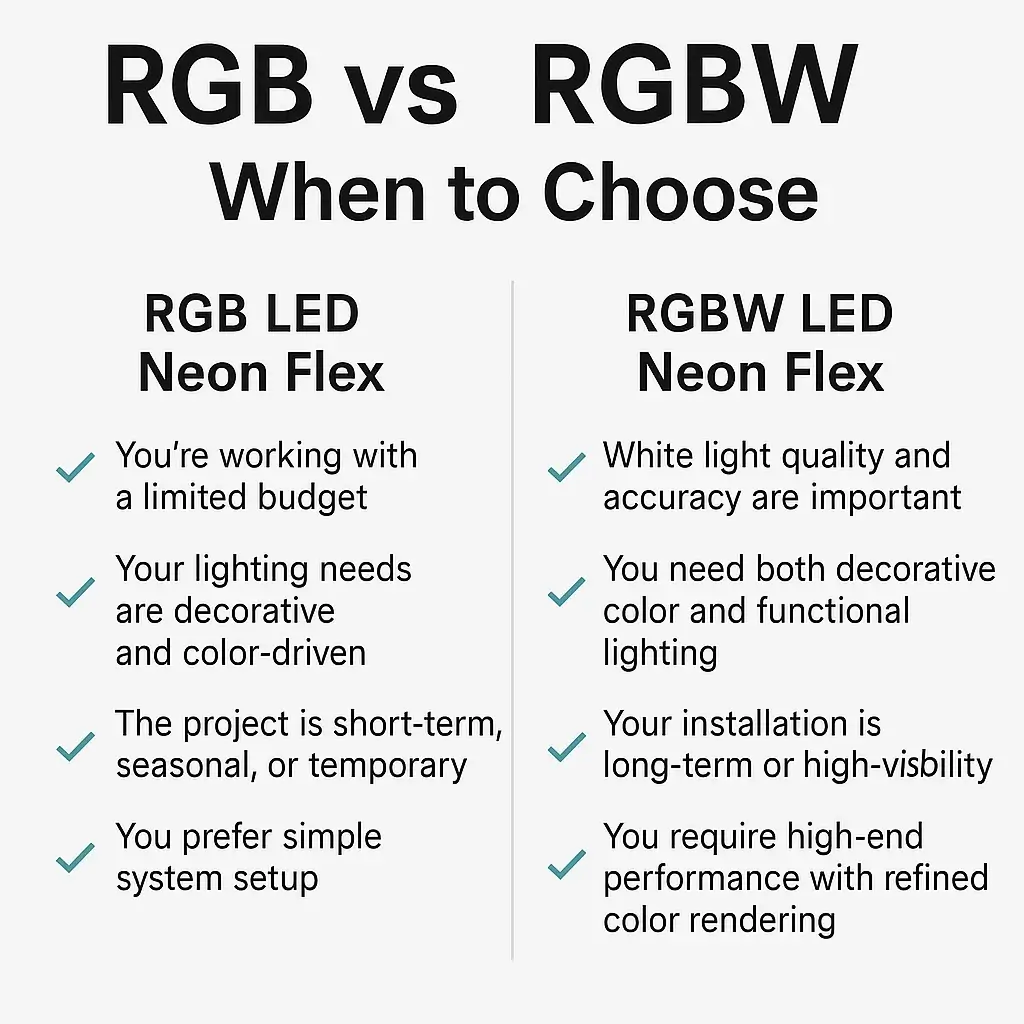
اتجاهات السوق: لماذا تكتسب تقنية RGBW LED نيون فليكس شعبية متزايدة في عام 2025
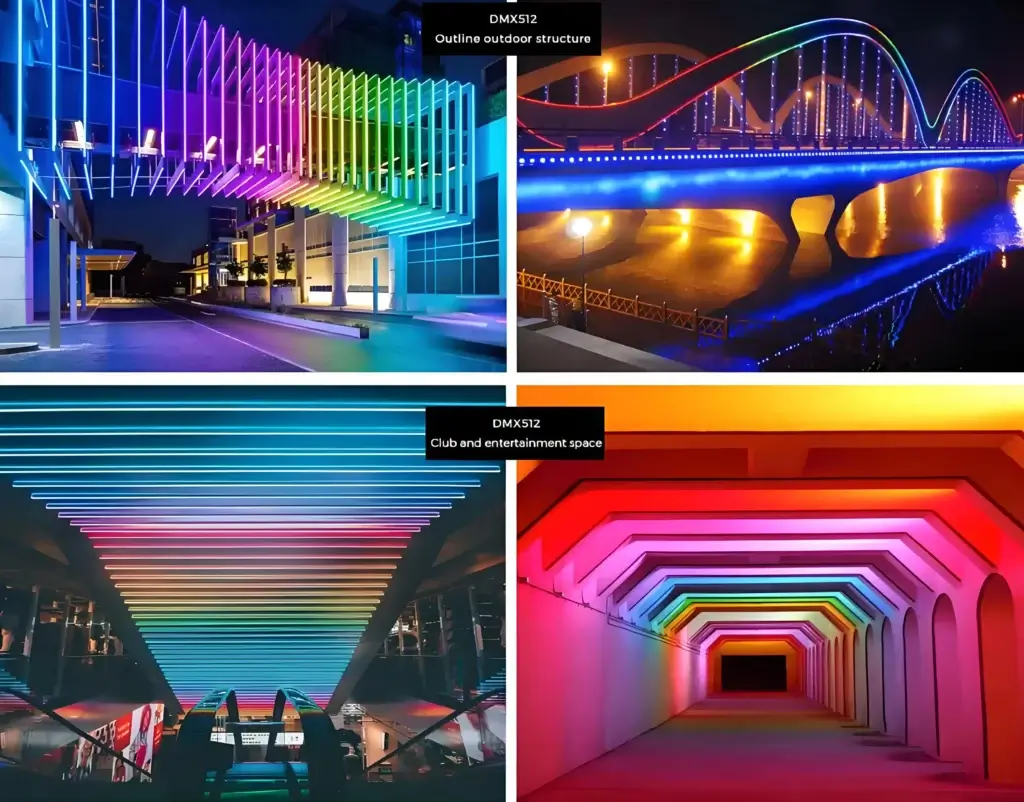
بينما ننتقل إلى عام 2025، أصبحت إضاءة (ليد نيون فليكس RGBW نيون فليكس بسرعة الحل المفضل لمشاريع الإضاءة المعمارية والتجارية والحضرية الراقية. تشهد هذه الصناعة تحولًا ملحوظًا من أنظمة الإضاءة التقليدية التي تعتمد على ألوان RGB فقط إلى تكوينات RGBW، ويرجع ذلك إلى حد كبير إلى الطلب المتزايد على الإضاءة البيضاء الحقيقية والعرض اللوني الفائق وحلول الإضاءة متعددة الوظائف التي تتكيف عبر بيئات وحالات استخدام متنوعة. ويأتي هذا التحول مدفوعًا بالعديد من الاتجاهات الرئيسية في قطاعي الإضاءة والإنشاءات:
1. التكامل مع المباني الذكية وأنظمة إنترنت الأشياء
نظرًا لأن المباني الذكية أصبحت أكثر انتشارًا، يبرز نظام نيون فليكس (RGBW) لمصابيح (ليد) بمصابيح (RGBW) كمكون أساسي للبنية التحتية للإضاءة الذكية. يتيح تصميمها المكون من 4 قنوات (أحمر وأخضر وأزرق وأبيض) إمكانية التكامل السلس مع البروتوكولات الحديثة مثل DMX512 وDALI وKNX، مما يدعم التحكم الكامل في تأثيرات الإضاءة وإخراج الضوء الأبيض.
في المجمعات المكتبية العصرية والفنادق الفاخرة ومساحات البيع بالتجزئة المتصلة، تتيح أنظمة الإضاءة RGBW التحكم المركزي في كل من الإضاءة المحيطة وإضاءة المهام، مما يوفر مستوى من التنوع لا يمكن أن توفره أنظمة RGB وحدها.
2. الطلب المتزايد على الإضاءة عالية الدقة في العلامات التجارية
تُعد حلول الإضاءة الآن أكثر من مجرد عناصر زخرفية، حيث تُعد حلول الإضاءة ضرورية للتعبير عن العلامة التجارية وإشراك العملاء. في المتاجر الرئيسية وصالات عرض البوتيكات وأماكن الضيافة، تُستخدم مصابيح RGBW نيون فليكس لإبراز المنتجات والمواد والهندسة المعمارية تحت إضاءة بيضاء دقيقة، مع تمكين الانتقال السلس إلى عروض ملونة وغامرة للعروض الترويجية أو الفعاليات أو الأجواء المحيطة.
هذه الإمكانية المزدوجة الغرض تجعل من RGBW أداة قيّمة للشركات التي تهدف إلى الجمع بين سرد القصص المرئية والوظائف التشغيلية.
3. التوسع في مشاريع الإضاءة الحضرية الكبيرة الحجم
تستثمر البلديات والمطورون الحضريون في جميع أنحاء آسيا وأوروبا والشرق الأوسط بكثافة في الإضاءة المعمارية وتجميل المدن. لقد أصبحت إضاءة (RGBW نيون فليكس) بتقنية (ليد) الحل المفضل لإضاءة الجسور وناطحات السحاب والفنون العامة والمعالم التاريخية - وذلك بفضل قدرتها على تقديم صور RGB المشبعة والمشرقة خلال المناسبات الخاصة والإضاءة البيضاء الأنيقة للعرض المعماري اليومي.
تدعم قابليتها للتكيف الإضاءة الديناميكية القابلة للبرمجة التي تحترم المظهر الجمالي والهوية المدنية.
4. تزايد الاستخدام في الأماكن العامة متعددة الأغراض
تعتمد المساحات متعددة الوظائف مثل المطارات والمتاحف والساحات ومراكز النقل على إضاءة نيون فليكس RGBW لتلبية متطلبات الإضاءة المتنوعة. تتطلب هذه الأماكن إضاءة بيضاء عالية الأداء للعمليات اليومية بينما تبحث أيضًا عن أنماط إضاءة غنية بالألوان للحملات الموسمية أو العروض أو الأحداث ذات الطابع الخاص.
إن قدرة RGBW على التبديل بين إضاءة المهام والإضاءة المحيطة بسلاسة تجعلها مثالية للبيئات العامة التي تتطلب كلاً من الأداء الوظيفي والذوق الإبداعي.
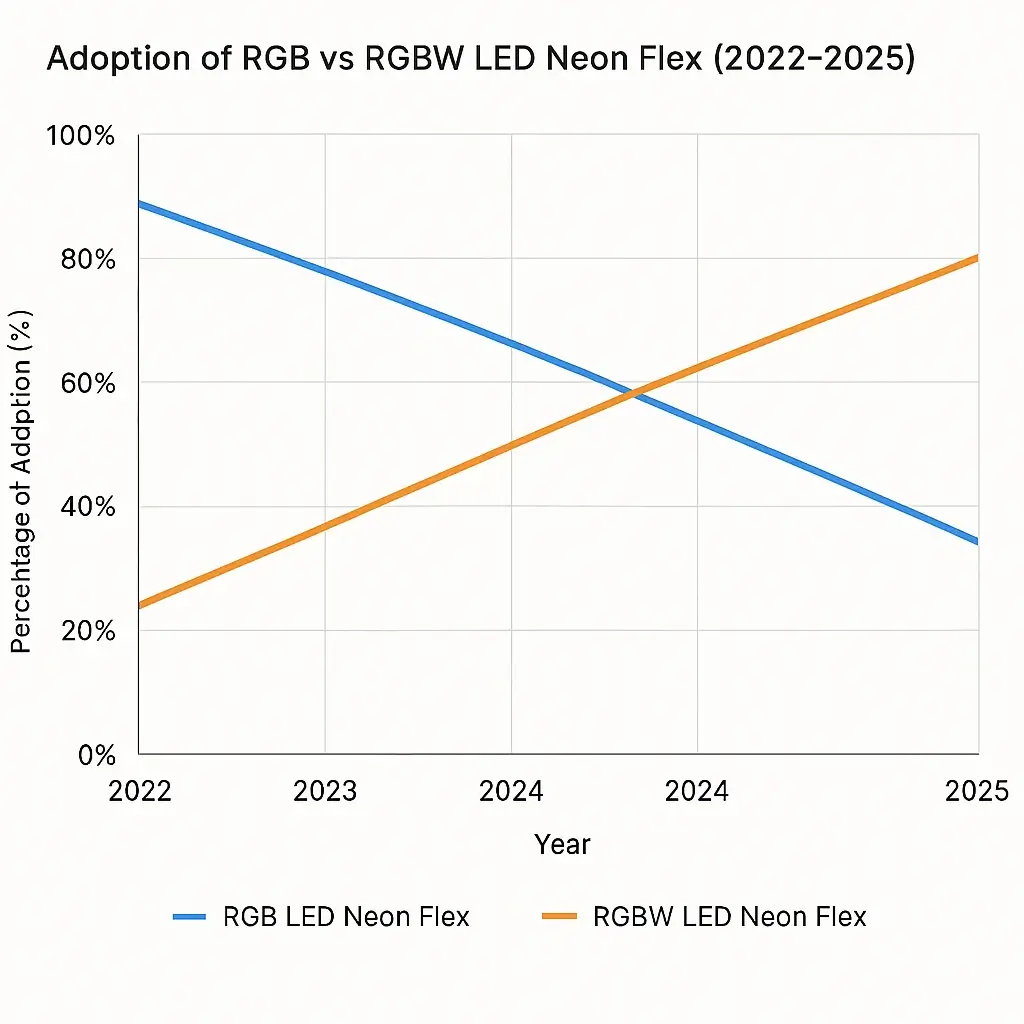
الأسئلة الشائعة (FAQ)
لا. يتطلب RGBW وحدة تحكم ذات 4 قنوات لإدارة مؤشر LED الأبيض المخصص. لن تعمل وحدة تحكم RGB ذات 3 قنوات على تنشيط القناة البيضاء أو تنظيمها بشكل صحيح، مما يحد من قدرات النظام.
بشكل عام، نعم. تسمح إضافة الصمام الثنائي الباعث للضوء الأبيض لـ RGBW بإنتاج ناتج إضاءة أعلى، خاصةً عند عرض الظلال البيضاء أو الباستيل، دون الاعتماد على الألوان الممزوجة من ثنائيات RGB.
ليس بالضرورة. غالبًا ما تكون مصابيح RGBW أكثر كفاءة في استهلاك الطاقة عند إنتاج الضوء الأبيض، نظرًا لأنها تستخدم شريحة بيضاء واحدة بدلاً من الجمع بين مصابيح LED حمراء وخضراء وزرقاء، والتي يمكن أن تستهلك المزيد من الطاقة لتحقيق مستويات سطوع مماثلة.
بالتأكيد. يحتفظ RGBW بإمكانيات RGB الكاملة ويوسع اللوحة بإضافة اللون الأبيض الحقيقي ومزج ألوان أكثر طبيعية، مما يؤدي إلى انتقالات أكثر سلاسة وعمق بصري أفضل.
بالنسبة للمشروعات التي تتطلب جودة إضاءة فائقة واستنساخًا دقيقًا للألوان وتنوعًا طويل الأجل، توفر إضاءة RGBW قيمة أعلى بكثير وعائدًا أفضل على الاستثمار (ROI) - خاصةً في بيئات الإضاءة التجارية والمعمارية والذكية.
الخلاصة: اختر بحكمة لنجاح الإضاءة على المدى الطويل
يُعد اختيار إضاءة (ليد نيون فليكس) المناسبة قرارًا استراتيجيًا يؤثر بشكل مباشر على المظهر المرئي والأداء الوظيفي والعمر الافتراضي لتركيب الإضاءة لديك. وسواء كنت تعمل على شاشة عرض مدمجة للبيع بالتجزئة أو واجهة معمارية كبيرة الحجم، فإن مواءمة اختيارك مع الأهداف المحددة لمشروعك ومتطلباته الفنية وميزانيته أمر ضروري لتحقيق نتيجة ناجحة. تظل مصابيح RGB LED نيون فليكس حلاً ممتازاً للمشاريع التي تعطي الأولوية للتأثيرات اللونية الزاهية والبساطة والفعالية من حيث التكلفة. وهو مناسب بشكل خاص للأماكن الترفيهية والعروض الترويجية الموسمية والتطبيقات ذات الميزانية المحدودة حيث تكون الإضاءة الديناميكية الجريئة هي الهدف الأساسي. من ناحية أخرى، يوفر لك نظام (RGBW) نيون فليكس (RGBW) ترقية كبيرة من حيث تنوع الإضاءة ودقة الألوان وإخراج الضوء الأبيض الاحترافي. وهذا ما يجعلها مثالية لبيئات البيع بالتجزئة الفاخرة والتصاميم الداخلية للشركات والمشاريع التي تتطلب إضاءة ذات طابع جمالي ووظيفة مهمة. أيًا كان اختيارك، تأكد من إقران مصابيح (ليد نيون فليكس) مع بروتوكول التحكم الصحيح (DMX512 أو SPI أو DALI) واستخدم استراتيجية تركيب جيدة التخطيط لضمان إضاءة موحدة وسلامة الإشارة والموثوقية على المدى الطويل.
هل تحتاج إلى مساعدة الخبراء في اختيار مصابيح LED نيون فليكس المناسبة؟
في SignliteLED، نحن لا نبيع الإضاءة فحسب، بل نقوم بتصميم الحلول الهندسية. حيث يعمل فريقنا بشكل وثيق مع المصممين والمهندسين المعماريين ومديري المشاريع لتقديم أنظمة نيون فليكس (LED) المخصصة التي تلبي أكثر مواصفات المشروع تطلبًا.
إليك كيفية دعمنا لنجاحك
تصميم الإضاءة المصممة خصيصًا والتخطيط الضوئي
إرشادات الخبراء بشأن RGB مقابل RGBW استناداً إلى تطبيقك
دعم تكامل النظام لعناصر التحكم DMX وDALI وSPI
توصيات بشأن المتانة والعزل المائي والإدارة الحرارية
دعم فني عند الطلب واستشارات ما بعد التثبيت عند الطلب
ابدأ مشروعك بـ سيجنليت ليد
دعنا نساعدك على إخراج رؤيتك إلى النور - بأداء ودقة واحترافية.
